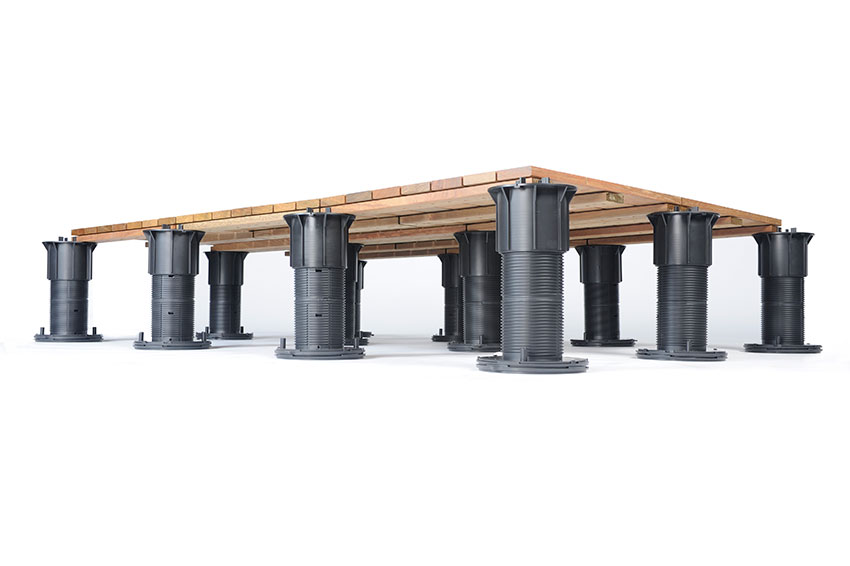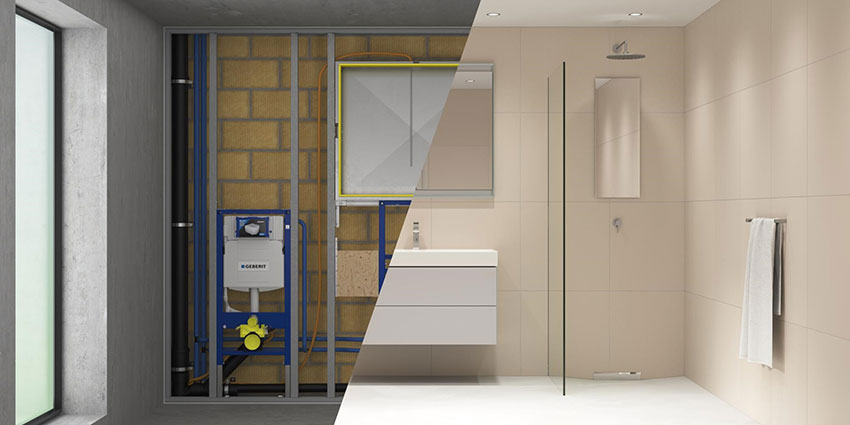Old Buildings – New Life
The concept of a wall-hung toilet system is not new, having been used on many commercial and institutional buildings for many years. What is new is the range of products available, including some European ones, that are appropriate for consideration in all types of building renovations/ adaptive reuse. Such systems help address the desire to use the existing shell walls by providing narrow profile designs that can readily fit inside many older wall configurations. This helps to reduce building costs and complexity by keeping the plumbing within the existing walls. Keeping inside the existing walls also means that drainage stacks and other existing plumbing can be re-used. That can reduce or eliminate the amount of floor coring for new piping that may otherwise be required.
In-wall systems also allow for more usable space and more revenue with a potential space gain of 6-9 inches per bathroom. This can add up quickly in multi-unit buildings such as multifamily or hotel settings. This is achieved in part by the adaptability of the system, which allows it to adhere to wall framing studs. The space savings mean more floor space in bathrooms allowing for a more spacious design. The raised fixture also means that cleaning is simplified since the flooring runs directly under the toilet thus eliminating the buildup of dirt or mold that can occur at the base of a floor-mounted toilet. Hence users can enjoy updated, contemporary bathrooms and spend more time living and not cleaning.
In terms of accessible design, the wall-mounted units can provide the added inches needed to meet clearances for maneuverability. The height of the toilet is also readily adjustable to meet accessibility standards where needed or provide standard heights where otherwise preferred and acceptable. The system typically includes wall-mounted, recessed actuators above the toilet since the tank is not visible for a flush valve handle or buttons. These actuators are essentially large buttons making them easier to use than standard options and thus more accessible for more people. Typically, two actuators are present for dual flushing capability – a lower and higher setting of flush water as may be needed.
This, coupled with typically smaller water storage tanks, equates to a more sustainable lower water use, and the related cost savings. In many cases, touchless flushing, with hands free activation, is also available where that option is desired or needed.
MODULAR PEDESTAL DECK COMPONENTS
As noted already, modular pedestal deck systems are versatile and can be incorporated into almost any renovation/ adaptive re-use project type to create usable, sustainable, and affordable outdoor spaces. They consist of standardized components that can be selected, specified, and customized to meet project needs, budget requirements, or green building goals. Regardless of where or how they are used, though, adjustable deck systems commonly incorporate three types of components as described in the following sections.

Photo: Bill Horsman; courtesy of Bison Innovative Products
Standard outdoor deck components can be customized and used creatively to create outdoor spaces consistent with renovation project goals.
Deck Supports
Fixed or adjustable height pedestals are the fundamental support system for outdoor decks and have become recognized as one of the most labor- and cost-efficient methods of creating a level deck over a moderately sloped surface. High-density polypropylene plastic that is 100 percent recyclable is a common material used to manufacture the supports. This makes them impervious to water, mold, and freeze-thaw cycles. Their adjustability offers tremendous design flexibility compared to traditional deck building materials and methods. Using a gravity system, the supports do not penetrate but rather protect roofing and waterproofing membranes thus causing no damage or harm to the surface below. The pedestals can be used to elevate the deck surface to meet the threshold, therefore providing an even and level transition from one space to another. This allows easy access for building occupants with varying levels of mobility.
The location of the pedestals is typically based on a modular layout that follows the size of the material used on the deck surface. Commonly, this is a 2-foot-by-2-foot square grid, although many other sizes are possible as well. Adjustable pedestals are available in a range of heights and weight-bearing capacities to suit a variety of conditions or needs. Those decks carrying more weight or requiring more height to achieve a level condition will need a higher grade of pedestal. Residential-, commercial-, and industrial- grades each have different characteristics. Deciding which system to specify is dependent on the support and elevation requirements of the deck in a project. Wind uplift pedestal systems have been designed to resist high-velocity wind when installed to the manufacturer’s specifications. Adjustable pedestal systems can support decks over occupied space, allowing space for electrical systems, duct work, and/or irrigation.
Deck Surfaces
The versatility of adjustable pedestal deck supports means that they can be used to elevate a variety of decking surface materials. The common options include pavers made from concrete or stone, such as granite or travertine. Similarly, structural porcelain tiles, fiberglass grating, composite materials, or conventional wood decking systems can be used in a grid pattern to meet different design requirements. Typically, a galvanized steel paver tray is adhered to the back of structural porcelain pavers or other materials prone to breakage to provide impact resilience and additional strength. The paver trays are available in a variety of standard sizes, compatible with large format ceramic tile sizes, and allow accommodation for thicknesses of 2 cm. With or without a support tray, the deck surface materials can be removed during building use for routine maintenance, repairs to the roof, or to gain access to other systems.
If a lighter weight surface material is preferred or required, wood tiles are a good alternative, weighing only one-third as much as concrete tiles. Typically made from hardwoods in a variety of species, wood tiles are generally commercial grade products. If maintaining the wood color is desired, wood tiles can be periodically cleaned and sealed. Left to weather naturally, the wood tiles will develop a silvery-gray patina. Wood tiles can be crafted from premium grade remnants and harvested in an environmentally responsible method designed to preserve the economic viability of rain forest hardwoods. Some manufacturers of wood tiles associate with governing groups such as the Forest Stewardship Council (FSC) to ensure the quality standards and practices of wood acquisition and plantation farming.
Site Furnishings
Manufacturers of pedestal deck systems also offer coordinated, modular elements that are designed to integrate with their deck systems while giving the architect complete design flexibility. Modular wood cubes are available with an array of design options to incorporate seating, storage, and planters. Such cubes are available with a polyurethane lining and drainage holes to host plant life. At other times of the year, the cubes can be repurposed for seating and storage of seasonal items (i.e., cushions and pillows) by placing a manufactured hardwood top on the cube.
If a different look is desired, aluminum cubes are also an option. Designed to withstand temperature extremes, these low-maintenance, durable planters are constructed of lightweight, partially recycled aluminum. Some use an industrial strength powder-coated finishing process that is applied electrostatically and cured under heat, creating a more resilient finish than conventional paint. There are a variety of size and color choices available.
Sustainability Features
Modular deck systems can contribute to well-known sustainability rating systems including LEED, SITES, WELL, and other green building certification systems. Some applicable areas of contribution are listed below:
LEED v4 BD+C
- Location and Transportation: Bicycle Facilities
- Sustainable Sites: Open Space, Heat Island Reduction
- Water Efficiency: Outdoor Water Use Reduction
- Materials and Resources: Building Life-Cycle Impact Reduction, Building Product Disclosure and Optimization, Environmental Product Declarations, Sourcing of Raw Materials, Material Ingredients
- Innovation: Innovation, Design for Flexibility (pilot credit), Walkable Project, Site (pilot credit), WELL Features (pilot credit)
- Site Design—Materials Selection: 5.3: Design for Adaptability and Disassembly; 5.5: Use Recycled Content Materials; 5.7: Support Responsible Extraction of Raw Materials; 5.8: Support Transparency and Safer Chemistry.
- Site Design—Human Health + Well-Being: 6.4: Support Mental Restoration 6.5: Support Physical Activity; 6.6: Support Social Connection.
Notice

www.bisonip.com

www.geberit.us









